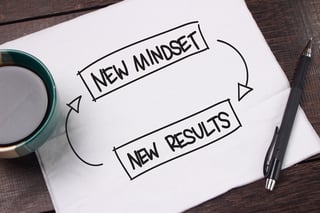 Did you notice the traditional year-end business predictions for 2021 never happened at the end of 2020? This seasonal staple was thrown out the window, like many of our routine practices last year.
Did you notice the traditional year-end business predictions for 2021 never happened at the end of 2020? This seasonal staple was thrown out the window, like many of our routine practices last year.
Everyone seemed more focused on making it through the year than trying to anticipate what might be coming next. (With everything that January threw at us, perhaps that was a wise decision!)
However, now that we are firmly into 2021, it seems a little safer to look forward. With that comes an increased focus on tackling difficult leadership challenges to move organizations forward.
To succeed in 2021, business leaders must steer teams away from an unhealthy focus on the past, reconcile employee desires with business needs, establish new revenue models, acquire new customers using different methods, and amend strategic planning initiatives.
A Focus on the Past
The fact that we are over a year into this does not change how difficult it is to face new leadership challenges. Everyone wants to “go back to the way things were,” but there is no going back from a business perspective. Where and how we work has changed permanently.
We have evolved.
Knowing where we came from helps guide where we are going, but it is not productive to recreate the past. Instead of dwelling on what we used to do and how we used to do it, encourage teams to take the best parts of before and merge them with the best parts of “now” to create a successful hybrid model that drives revenue and increases customer and employee satisfaction.
Continued Flexibility
When we do go back to the office, employees still want flexibility. But what will that look like?
- Will the entire organization change, or will it be up to personal preference to choose between remote and in-office work?
- Will employees be in the office a few days a week or only for meetings?
- Should companies still have the same time-commitment expectations of employees?
- Will there still be work-related travel, or will professional development, trade shows, networking, B2B sales, and other previously travel-heavy activities become fully remote?
These are questions that most companies will be asking over the next year. Leadership will be tasked with developing a plan that prioritizes employees' physical and mental health while maintaining profitability.
An article from the Facebook Tech team explains,
“Employees are overtaxed by the demands of work, and research indicates they're not the only ones.... 71% of executives said 2020 was their most-stressful work year ever, and 53% reported struggling with mental health issues at work. Focusing on improving employee well-being is not only the right thing to do, but companies are also aware that it leads to increased business performance. That's why they’re looking for tech and other tools to boost job satisfaction, worker health, sustainability, work-life balance, and flexible working arrangements.”
Of course, if the workday or workweek changes, the way employee performance is measured may need to change as well.
Amy Leschke-Kahle sheds some light on this challenge when she says,
“Organizations must start defining work based on activity and contributions, not hours and location. In a sense, we have to rethink and redefine what work is on a fundamental level. Making this shift can bring up questions about compensation, downstream talent processes, and measuring performance. Many of these approaches will need to be adjusted as the world of work changes, but the most pressing tasks in the coming year will be engaging and investing in our people, and ensuring that we are evaluating them based on their contributions, not just the hours they work.”
This shift will likely be harder to embrace at companies where long workdays and an always-connected mindset have traditionally been the hallmarks of success.
Understanding Revenue
The way we price services and bill our time has changed, which will undoubtedly continue to have revenue implications.
For instance, before COVID, attorneys may have had to bill several hours for a court date to cover the time required to commute, wait at the courthouse, and be present for the entire duration of the hearing even though they only needed to talk for a few minutes. Now that most courthouses are closed for in-person hearings, attorneys can be far more efficient with their time. Their revenue may be down, but their job satisfaction is likely way up.
Self-employed individuals can make a judgment call about whether this trade-off is worth it for them personally, but what about organizations that have revenue numbers to meet and rely on their employees’ billable hours to do so? These companies need to figure out how much work is enough to hit revenue targets and achieve long-term business goals. When there is a deficiency, they need to determine what to do without enough hours to get them there.
New Parameters
Your old team is working with new parameters in a new environment, which means the team can adapt or new talent needs to be brought in. There are wins and losses across all businesses in the wake of last year’s changes that may need to be addressed through staffing changes. In many cases, the way we define success has changed. In some instances, the KPIs themselves have changed as well. Leaders must manage teams as they adapt to these changes and make the personnel decisions needed to keep the organization moving forward.
Finding and Serving Customers
There are some barriers this year that are particularly relevant to customer acquisition. Sales and marketing teams will need to figure out how to serve the same clientele amid a rapidly changing business landscape.
Pre-pandemic, a majority of B2B businesses operated in both the in-person and online worlds. In the months since, sales teams have had to figure out how to make new connections, maintain existing relationships, and close sales. Marketing also faces unique challenges in a pandemic world because sales’ reliance on marketing is more important than ever before. As a result, marketing teams must find even more ways to connect the sales team with new opportunities.
Digital remains the key to unlocking revenue sources – online introductions, live chat pre-, post-sales support, virtual demos, and self-service sales models.
A recent McKinsey article reminds us,
“Remote channels—telephone and digital—have become steadily more crucial in managing customer relationships and generating revenues. Even before the pandemic hit, these customer touchpoints occurred two to four times more frequently than traditional in-person interactions, and the spread continues to widen. As customers grow increasingly comfortable using them, these remote channels create a significant revenue opportunity.”
Sales and marketing must also work alongside customer service teams to make the customer journey smooth and seamless.
Shifting Strategic Planning
Executive leadership may be getting frustrated and discouraged that there is no end in sight to the constant need to re-plan. While rework can be discouraging, planning remains more critical than ever.
An article on current work trends reminds us,
“Today, the traditional year-long or years-long approach to strategic planning is less than irrelevant; it's an altogether bad use of time. But that doesn't mean there's no need to plan. What's really happening here is that how we engage with strategic planning — our mindset frequency — has to change. We need to enable our teams to plan in shorter chunks of time so we can counter sudden changes with insightful next steps.”
Organizations and teams have things they want to accomplish this year. These 2021-specific challenges and barriers raise many questions that must be answered before your leadership can develop an effective strategic revenue plan.

